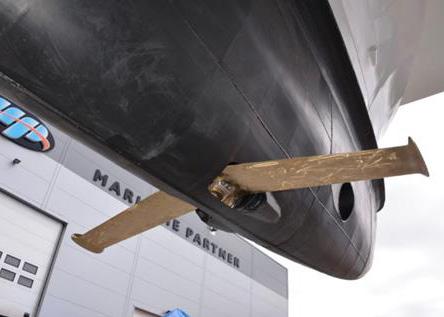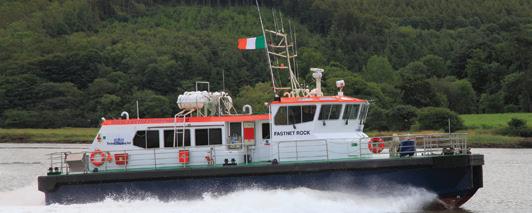
3 minute read
CHANGING NAUSEATING HEAVE INTO FORWARD MOTION
Wavefoil AS is pioneering the use of foil propulsion in commercial vessels: a principle that has been around for a while, but with carbon reduction and crew welfare imperatives has been pushed back up the naval architectural ‘to do’ list
Because the pitching movement of boats rises and falls about a (moving) pivot point somewhere around its centre of buoyancy, usually somewhere amidships, the stern and particularly the rather finer bow rises and falls vertically rather more than any other part of the vessel.
Motion capture
For many years, designers have reasoned that placing a roughly horizontal foil underwater up by the bow, sometimes hinged at a point forward of the foil’s centre of lift, would allow that foil to capture some of this lost up and down motion, converting it into forward thrust, rather like a whale’s tail describes an upwards and downwards motion, propelling the mammal forwards.
There is another benefit to capturing this energy from vertical accelerations - it reduces accelerations, so not only does a vessel so equipped transit more efficiently (Wavefoil says 5-15% more efficiently), it also offers much improved comfort, particularly when it comes to the larger seasicknessgenerating upwards and downwards movements aptly known as ‘heave’.
Like a lot of theories in naval architecture (we’re looking at you, bubble hull lubrication!), getting a technology from working in theory and in small boat tests to becoming a viable commercial proposition is a major step and that was where foil propulsion was until Wavefoil came along.
There had been some interesting small boat studies, and encouraging videos of small craft gamely battling their way upwind and upwave with the miraculous seeming power of foil propulsion, but it was never a technology that vessel operators could buy off the shelf.
Wavefoil AS, though, has fixed one of the potential major issues. The vulnerability of wide, high aspect foils just below the waterline at the slender bow part of a ship was a big worry, but Wavefoil has solved this with a patented design that retracts entirely into the hull for berthing and for a more efficient hull when the vessel is moving in calm water.
In entirely flat water the foils have no upward and downward energy to capture, so are better retracted as in these rare situations they only act as drag.
Wavefoil’s testing has also concluded that leaving the foils deployed can induce bow diving in certain following sea conditions, further underlining the necessity of retractable foils.
Celebrated reference
MS Thea Jensen, a celebrated ambulance vessel built for shipowner Loppa Legeskyssbåter by Maritime Partner in Norway, is one of the better known references for Wavefoil.
This 22m aluminium catamaran principally employs Wavefoil for reduced vertical accelerations - crucial when a vessel actually has a fully staffed emergency room and potentially very sick patients aboard.
She is stationed in Øksfjord in the North of Norway and will be operated in the area of Loppa, Hasvik and the outer
Altafjord. The shipowner signed an 8 + 1 + 1 year contract with Finnmark Hospital in Hammerfest to operate the service.
Along with other ground-breaking technologies the Wavefoil foil system received positive feedback from the sea trials. This was designed to reduce rolling / stamping in the sea by about 30%. According to Maritime Partner, ‘the Wavefoil system has worked very well during testing and probably has an efficiency that exceeds calculations. The result is that crew, patients and passengers have a much calmer journey’.
Wavefoil extensively tested MS Thea Jensen’s ride quality before the vessel was delivered. The vessel motions were measured at a speed of about 29.5 knots with and without foils, for a significant wave height of 1 metre and a peak wave period of 8 seconds.
The vertical accelerations were dampened by up to 25% for the given sea state. The measurements also showed motion damping in beam sea conditions. In the following swell that occurred in this test, there was a slight negative effect of having the foils deployed, demonstrating the need for retractable bow foils.
Simulations performed using the ShipX software from SINTEF Ocean show that the benefits of the bow foils are larger for lower wave periods than for the wave period in the full-scale MS Thea Jensen test. The response from the crew after operating the vessel in lower wave periods confirms this. The simulations also show that the vessel can operate in significantly higher waves without wetdeck slamming by having the bow foils deployed.
Catamaran wetdeck slamming, although it does not always relay the most dramatic acceleration in terms of the raw numbers, is noisy and potentially alarming for passengers, so this reduction has a significantly powerful psychological effect.










